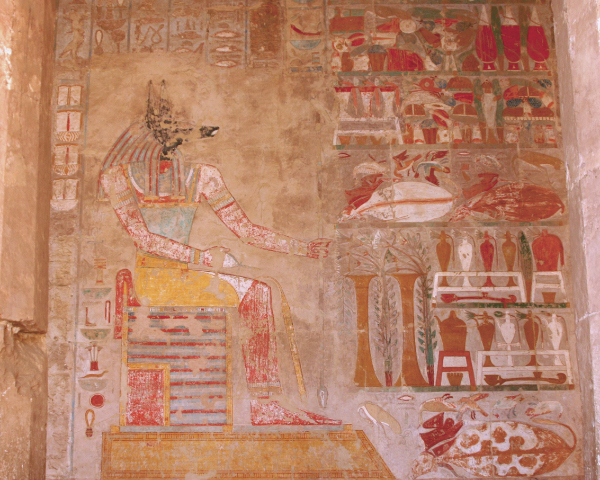Haggai’s Fourth Oracle (2:10–23)
Twenty-fourth day of the ninth month (2:10). The prophet is receiving a new word about two months after his last oracle. It is not clear to whom the oracle is addressed, though the use of second person plural references in what follows suggests the community as a whole.
Consecrated meat (2:12). Once a sacrifice is offered to God, it is considered to be set aside and devoted to God; thus, it shares in God’s holiness. As such there are specific rules governing who may, and who may not, partake of the meat (Lev. 7:20). The point here is that other items do not automatically become holy by contact with something that is consecrated; it takes an intentional action of devoting something to God to impart holiness.

Food offerings before the god Anubis include several whole cows, a thigh, and several fowl.
William Benson
Wine vat (2:16). When grapes were brought in from the harvest, they were crushed and the resulting juice stored in a large vat in order for the sediments and pieces of grape to settle out. It began fermentation in the vat, but the final processing occurred when drawn off into storage jars or skins. The image here relates to the processing of the harvest for future use.
Vine and the fig tree, the pomegranate and the olive tree (2:19). These are all late summer crops whose harvest would be long past by the ninth month (also known as Chislev, approximately November-December). They would be dormant at the point of Haggai’s proclamation. But the promise of this oracle is that, though at this point these crops are not currently bearing, with the restoration of the temple the community can anticipate abundance in the coming agricultural cycle.
I will bless you (2:19). In the ancient Near East, people believed there was a direct connection between honoring the deity and agricultural productivity. By establishing a permanent place where regular sacrifices were offered to a god, the community could assume the honored god would respond with prosperity in the form of abundant crops (see sidebar on “A Promise to King Gudea of Sumer”). Israel shares in this perspective, for they see obedience to God as a means to economic prosperity (see, e.g., Deut. 7:12–15).
Chariots and their drivers; horses and their riders (2:22). One of the innovations of the Persian army was the extensive use of cavalry in battle, something no other force could match until the coming of Alexander the Great.6
My signet ring (2:23). In the ancient Near East, a signet ring was an engraved stone bearing a mark that was unique to the individual. Such signets were used to sign contracts and/or legal documents or to emboss seals of scrolls, and they could be entrusted to a trusted servant.

Signet ring
Z. Radovan/www.BibleLandPictures.com
Bibliography
Gershevitch, I., ed. The Cambridge History of Iran. Vol. 2: The Median and Achaemenian Periods. Cambridge: Cambridge Univ. Press, 1985. A fine synthesis of the sweep of the Persian empire from its origins to its collapse.
Grabbe, Lester L. A History of the Jews and Judaism in the Second Temple Period. Vol. 1: Yehud: A History of the Persian Province of Judah. London: T. & T. Clark, 2004. Though often unnecessarily skeptical of biblical narratives, this is the most up-to-date synthesis of archaeological, biblical, and historical information on Palestine in the Persian period.
Kessler, John. The Book of Haggai: Prophecy and Society in Early Persian Yehud. VTSup 91; Leiden: Brill, 2002. A thorough and balanced effort to interpret Haggai in the light of what we know about the Persian period.
Meyers, C. L., and E. M. Meyers. Haggai, Zechariah 1–8: A New Translation with Introduction and Commentary. AB; New York: Doubleday, 1987. By far the most penetrating and extensive commentary to date on Haggai with extensive background information.
Chapter Notes
Main Text Notes
1. For a relatively recent overview on the Persian empire in this time, see Cambridge Ancient History, 2nd ed.; vol. 4, Persia, Greece, and the Western Mediterranean (c. 525 to 479 B.C.), ed. J. Boardman, N. G. L. Hammond, D.-M. Lewis, and M. Ostwald (Cambridge: Cambridge Univ. Press, 1985).
2. See H. Tadmor, “ ‘The Appointed Time Has Not Yet Arrived’: The Historical Background of Haggai 1:2,” in Ki Baruch Hu: Ancient Near Eastern, Biblical, and Judaic Studies in Honor of Baruch A. Levine, ed. R. Chazan, W. Hallo, and L. Schiffman (Winona Lake, Ind.: Eisenbrauns, 1999), 401–8. For matters in the history of the Persian empire, an excellent resource is P. Briant, From Cyrus to Alexander: A History of the Persian Empire, trans. P. Daniels (Winona Lake, Ind.: Eisenbrauns, 2002).
3. A variety of options are explored by C. L. Meyers and E. M. Meyers, Haggai, Zechariah 1–8 (AB 25B; Garden City, N.Y.: Doubleday, 1987), 10–11.
4. See M. Nissinen, References to Prophecy in Neo-Assyrian Sources (SAAS 7; Helsinki: Univ. of Helsinki Press, 1998), 37–8, 164–65.
5. CTA 4.7.29–35 as trans. by Frank Moore Cross, Canaanite Myth and Hebrew Epic: Essays in the History of the Religion of Israel (Cambridge: Harvard Univ. Press, 1973), 148–49.
6. J. M. Cook, The Persian Empire (New York: Schocken, 1983), 102–3.
Sidebar and Chart Note
A-1. D. O. Edzard, Gudea and His Dynasty (RIME 3, I; Toronto: Univ. of Toronto Press, 1997), 71–75.
